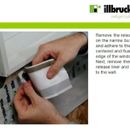An Illbruck vapor-permeable window flashing tape for the sill?
Stumbled upon a window flashing illustration that shows a flashing tape being used on the OUTSIDE of a window flange at the sill (see image.) The tape has a butyl layer strip for the window flange, and possibly a adhesive backing on the lower portion (not clear), like it creates a vapor permeable pocket/flap.
[I guess you could craft something similar with narrow flashing tape and permeable housewrap.]
Anyone seen, used, or have any info or comments on this?
I haven’t had much luck Googling for specifics on that exact product.
The Powerpoint installation is at> http://www.willsealusa.com/application_windows.html
In the image at the sill, there is a housewrap layer, a sill pan flashing tape, and then some hands installing the final flashing over top the window flange.
GBA Detail Library
A collection of one thousand construction details organized by climate and house part










Replies
Bob,
I suggest that you contact:
Willseal USA
1 Industrial Drive
Pelham, NH 03076
800-274-2813
http://www.willsealusa.com
I wrote about the product you are describing in the Aug. 2004 issue of <Energy Design Update.
I wrote, in part:
"Most window manufacturers require caulk at the bottom fin to limit air infiltration and the intrusion of wind-driven rain. On the other hand, those who advise omitting caulk from the bottom fin — a group which includes sill pan manufacturers — want to provide an exit path for any bulk water that leaks onto the rough sill. Those straddling this controversial fence may want to consider sealing the bottom fins of their windows with a new product, Illbruck 2112 vapor permeable tape. (Confusingly, Illbruck makes several tapes designated as Illbruck 2112, including a different product called Illbruck 2112 insulation tape. Illbruck 2112 vapor permeable tape is item number 22946.) Illbruck vapor permeable tape is specifically designed for window bottom fins. It is a 4-inch wide 20-mil-thick non-woven polypropylene cloth tape with two thin strips of butyl adhesive along the edges. The center of the tape has no adhesive and is vapor permeable. When the tape is used to seal an uncaulked bottom fin to the housewrap, it limits air and water intrusion while still allowing water to drool or diffuse out through the tape.
"Illbruck recommends installing a site-built, sloped sill pan, using shims and flexible peel-and-stick flashing. The window is installed in the rough opening with sealant under the side fins and the head fin, but not the bottom fin. Once the window is installed, a piece of vapor permeable tape 3 inches longer than the width of the rough opening is used to seal the exterior of the bot- tom window fin to the housewrap. The narrow (top) strip of butyl adhesive adheres to the window fin, while the wider (bottom) strip of adhesive adheres to the housewrap. Illbruck advises that vapor permeable tape should not be installed at temperatures below 41°F.
"Vapor permeable tape should only be used at bottom fins, not side or top fins. These other three fins should be sealed with flexible flashing. Illbruck’s instructions warn against extending the side flashing too far at the bottom, because the corners of the vapor permeable tape should not be covered with a product that limits diffusion or drooling. The idea is to leave a “dribble path” at a window’s lower corners.
"... Illbruck 2112 vapor permeable tape (item number 22946) comes in rolls measuring 4 inches wide by 82 feet long. It is available from Shelter Supply for $0.47 per foot (about $39 per roll)...."
thx martin, google search didn't hit your review
has there been a bga article on which sill approach seems to perform best?